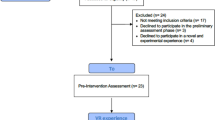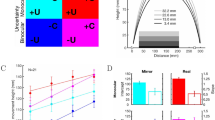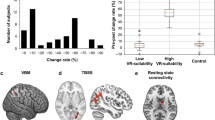Abstract
Virtual reality (VR) has finally come of age for serious applications in the behavioral neurosciences. After capturing the public imagination a decade ago, enthusiasm for VR flagged due to hardware limitations, an absent commercial market and manufacturers who dropped the mass-market products that normally drive technological development. Recently, however, improvements in computer speed, quality of head-mounted displays and wide-area tracking systems have made VR attractive for both research and real-world applications in neuroscience, cognitive science and psychology. New and exciting applications for VR have emerged in research, training, rehabilitation, teleoperation, virtual archeology and tele-immersion.
This is a preview of subscription content, access via your institution
Access options
Subscribe to this journal
Receive 12 print issues and online access
$209.00 per year
only $17.42 per issue
Buy this article
- Purchase on Springer Link
- Instant access to full article PDF
Prices may be subject to local taxes which are calculated during checkout




Similar content being viewed by others
References
Gibson, J.J. The Ecological Approach to Visual Perception 3 (Houghton Mifflin, Boston, 1979).
Spiro, J.E. Going with the (virtual) flow. Nat. Neurosci. 4, 120 (2001).
Foley, J.D. Interfaces for advanced computing. Sci. Am. 257, 126–135 (1987).
Lanier, J. Virtually there. Sci. Am. 284, 66–75 (2001).
Hafner, K. Real queasiness in virtual reality. The New York Times, November 19, 1998.
Aginsky, V., Harris, C., Rensink, R. & Beusmans, J. Two strategies for learning a route in a driving simulator. J. Environmental Psychol. 17, 317–331 (1997).
van Veen, H.A., Distler, H.K., Braun, S.J. & Bulthoff, H.H. Navigating through a virtual city: using virtual reality technology to study human action and perception. Future Generation Computer Systems 14, 231–242 (1998).
Cruz-Neira, C., Sandin, D., DeFanti, T., Kenyon, R. & Hart, J. The CAVE—audio visual experience automatic virtual environment. Communications ACM 35, 65–72 (1992).
Loomis, J.M., Blascovich, J.J. & Beall, A.C. Immersive virtual environment technology as a basic research tool in psychology. Behav. Res. Methods Instruments Computers 31, 557–564 (1999).
Warren, W.H. & Hannon, D.J. Direction of self-motion is perceived from optical flow. Nature 336, 162–163 (1988).
Warren, W.H., Kay, B.A., Zosh, W.D., Duchon, A.P. & Sahuc, S. Optic flow is used to control human walking. Nat. Neurosci. 4, 213–216 (2001).
Kearns, M.J., Warren, W.H., Duchon, A.P. & Tarr, M.J. Path integration from optic flow and body senses in a homing task. Perception 31, 349–347 (2002).
Riva, G., Wiederhold, B.K. & Molinari, E.E. (eds.) Virtual Environments in Clinical Psychology and Neuroscience (Ios, Amsterdam, 1998).
Virtual reality aid for schizophrenia. BBC News Online, Health. http://news.bbc.co.uk/1/hi/health/2066973.stm (June 26, 2002).
North, M.N., North, S.M. & Coble, J.R. in Virtual Environments in Clinical Psychology and Neuroscience (eds. Riva, G., Wiederhold, B. K. & Molinari, E.) 112–119 (Ios, Amsterdam, Netherlands, 1998).
North, M.M., North, S.M. & Coble, J.R. Virtual environment psychotherapy: a case study of fear of flying disorder. PRESENCE, Teleoperators Virtual Environments 6, 127–132 (1997).
North, M.M., North, S.M. & Coble, J.R. Effectiveness of virtual environment desensitization in the treatment of agoraphobia. PRESENCE: Teleoperators and Virtual Environments 5, 346–352 (1996).
Riva, G. in Virtual Environments in Clinical Psychology and Neuroscience (eds. Riva, G., Wiederhold, B. K. & Molinari, E.) 191–199 (Ios, Amsterdam, Netherlands, 1998).
Serruya, M.D., Hatsopoulos, N.G., Paninski, L., Fellows, M.R. & Donoghue, J.P. Brain-machine interface: instant neural control of a movement signal. Nature 416, 141–142 (2002).
Vote, E., Acevedo, D., Laidlaw, D.H. & Joukowsky, M. Discovering Petra: archaeological analysis in VR. IEEE Comput. Graphics Applications 22, 38–50 (2002).
Wanke, L.A. & DuBose, R.F. Designer drugs: the evolving science of drug discovery. Pharm. Pract. Manag. Q. 18, 13–22 (1998).
Zhang, S., Demiralp, Ç. & Laidlaw, D.H. Visualizing diffusion tensor MR images using streamtubes and streamsurfaces. IEEE Trans. Visualization Comput. Graphics (in press).
Acknowledgements
The VENLab was funded by a Learning and Intelligent Systems (LIS) award from the National Science Foundation (IRI-9720327) to W.H.W., M.J.T. and L.P. Kaelbling (now at M.I.T.). We thank the students and postdocs who have collaborated with us on the VENLab over the years and D. Laidlaw for his contributions to this article.
Author information
Authors and Affiliations
Rights and permissions
About this article
Cite this article
Tarr, M., Warren, W. Virtual reality in behavioral neuroscience and beyond. Nat Neurosci 5 (Suppl 11), 1089–1092 (2002). https://doi.org/10.1038/nn948
Received:
Accepted:
Published:
Issue Date:
DOI: https://doi.org/10.1038/nn948
This article is cited by
-
Effectiveness of virtual reality-based programs as vestibular rehabilitative therapy in peripheral vestibular dysfunction: a meta-analysis
European Archives of Oto-Rhino-Laryngology (2023)
-
Perceived usefulness of, engagement with, and effectiveness of virtual reality environments in learning industrial operations: the moderating role of openness to experience
Virtual Reality (2023)
-
Relationship between electroencephalographic data and comfort perception captured in a Virtual Reality design environment of an aircraft cabin
Scientific Reports (2022)
-
Remote virtual reality as a tool for increasing external validity
Nature Reviews Psychology (2022)
-
Multiple spatial frames for immersive working memory
Nature Human Behaviour (2022)



